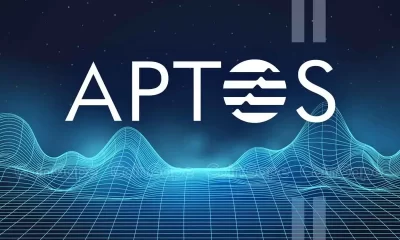Uncategorized
Sacks and his VC firm sold over $200M in crypto and stocks before WH role
Published
3 months agoon
By
admin
David Sacks and his venture capital firm sold over $200 million in crypto and crypto-related stocks before he commenced his role as the White House AI and crypto czar, a White House memorandum disclosed.
“You and Craft Ventures have divested over $200 million of positions related to the digital asset industry, of which $85 million is directly attributable to you,” said the memorandum dated March 5.
Crypto sell-off in an effort to prevent conflict of interest
The memorandum said “significant steps” were taken to reduce potential conflicts of interest before Sacks began his tenure as the White House AI and crypto czar — in which a major part of his role is to help create a legal framework for the crypto industry.
Sacks offloaded all the “liquid cryptocurrency” in his portfolio, as well as Craft Ventures’ portfolio — the investment firm he co-founded in 2017 — including holdings in Bitcoin (BTC), Ether (ETH), and Solana (SOL) before US President Donald Trump’s inauguration on Jan. 20.
The memorandum outlined which cryptocurrencies and crypto-related stocks David Sacks sold prior to Trump’s inauguration. Source: The White House
Since Trump’s inauguration, the crypto market has seen a major decline amid a broader market downturn, with many blaming Trump’s proposed tariffs and uncertainty over US interest rates.
While Bitcoin tapped a new all-time high of $109,000 just hours before Trump was sworn in as the 47th US president, it recently dipped below $80,000 on Feb. 27, erasing all post-election gains. At the time of publication, Bitcoin is trading at $84,155, as per CoinMarketCap data.
Sacks also divested from publicly traded crypto-related firms, including Coinbase (COIN), Robinhood (HOOD), and stakes in private digital asset companies.
Additionally, he sold his limited partner interest in Solana-focused Multichain Capital and crypto-focused venture capital firm Blockchain Capital. At the same time, Craft Ventures offloaded its holdings in Multichain Capital and Bitwise Asset Management.
Sen. Warren urged Sacks to prove he no longer holds crypto
The memorandum is dated one day before Massachusetts Senator Elizabeth Warren urged Sacks in a March 6 letter to prove he no longer holds any digital assets, following Sacks’ claim in an X post that he sold off all his crypto.
“Despite your public statements via X, it remains unclear exactly when you personally divested from BTC, ETH, and SOL, when Craft Ventures divested from Bitwise, and whether people close to you ‘may have held positions and sold into the recent price surge,” Warren said.
Since Sacks started the White House crypto role, he has been a vocal advocate on various issues in the crypto industry, from the importance of a Strategic Bitcoin Reserve to not over-taxing the crypto industry.
Related: Bitcoin panic selling costs new investors $100M in 6 weeks — Research
Sacks recently shut down the idea of crypto transaction taxes on an episode of the All In Podcast after host Jason Calacanis proposed charging a 0.01% tax on every cryptocurrency transaction.
“That’s always how taxes start. They are described as being very modest,” Sacks said.
“You know, when the income tax started, it only applied to like a thousand Americans, and the legislators swore up and down that it would never be applied to middle-class people,” Sacks added.
Magazine: Crypto fans are obsessed with longevity and biohacking: Here’s why
Ethereum Price Headed For Crash To $2,000 With Current Price Action Tokenized funds hit $5.7B, scaling fast — Moody’s Authorities Warn of Phony Text Messages Phishing for Sensitive Information, Telling Victims Their Bank Account Is at Risk Tether invests in Chilean crypto exchange Orionx MARA Hits Record-High Bitcoin Production in May Retail investors no longer FOMO into BTC, altcoins Published on By Tokenized short-term funds, a new class of digital financial products bridging traditional and decentralized finance, have grown to reach $5.7 billion in assets since 2021, according to a new Moody’s report. The credit rating service sees growing interest from traditional asset managers, insurers, and brokerages looking to offer clients access between fiat and digital markets. “Tokenized short-term liquidity funds are a small but rapidly growing product,” notes a June 3 report shared with Cointelegraph. These funds, typically backed by US Treasurys or other low-risk assets, operate similarly to traditional money market funds but use blockchain to issue and manage fractional shares, enabling real-time settlement. Data from the Federal Reserve shows that US money market funds held approximately $7 trillion in total assets as of December 2024. According to Moody’s, emerging use cases for tokenized funds may include yield optimization for institutional investors versus stablecoins, liquidity management for insurance companies, and use as collateral in trading and lending operations. “We expect the AUM of this space to grow because most major wealth brokerages, private bank and asset management platforms that offer digital assets will likely use a cash-sweep type product like a tokenized short-term liquidity fund to regularly move uninvested cash into a yield earning product.” A handful of players is leading the sector’s growth. BlackRock’s USD Institutional Digital Liquidity Fund leads the pack with $2.5 billion in assets under management, followed by Franklin Templeton’s OnChain US Government Money Fund with $700 million. Other key players include Superstate, Ondo Finance and Circle, whose funds each manage between $480 million and $660 million. Companies are also looking at tokenization as a tool to reach broader markets. German protocol Midas recently announced a tokenized certificate backed by US Treasury bills for European investors, offering exposure to yield-bearing government bonds with no investment minimum required. In May, brokerage firm Robinhood made a similar move to offer investors in Europe exposure to US markets. In addition, the company recently submitted a proposal to the US Securities and Exchange Commission (SEC) for a tokenization regulatory framework in the country. According to Robinhood CEO Vlad Tenev, “tokenization represents a new paradigm for institutional asset allocation.” Beyond the credit and liquidity risks typical of money market instruments, tokenized funds also face vulnerabilities tied to blockchain technology, the report notes. These include smart contract flaws, cyber threats, network availability and regulatory uncertainty. “[…] asset representation risks may arise from discrepancies between the blockchain registry and other shareholder records concerning the legal ownership of shares,” the report says. Magazine: Danger signs for Bitcoin as retail abandons it to institutions — Sky Wee Published on By Despite the widespread belief that retail investors have exited the cryptocurrency space, that’s not the case. According to Vugar Usi Zade, chief operating officer of Bitget, they’ve simply changed their approach. In an interview with Cointelegraph at the Consensus conference in Toronto, Canada, Usi Zade explained that retail trading has shifted away from rampant speculation and toward more practical and sustainable use cases. He attributes this change, in part, to lingering PTSD from the last crypto market cycle, as well as broader macroeconomic uncertainty fueled by the Trump administration, which has placed downward pressure on risk assets throughout 2025. “Retail investors’ appetite for risk is much lower because we know what happened with the stock market and every other aspect,” Usi Zade said. “There’s less disposable income to play around with, but people are becoming smarter with their investments.” Bitget is responding to this behavioral shift by expanding into crypto payments and utility-driven services, including Bitget Pay and stablecoin solutions. The fallout from the 2021 bull run, followed by a harsh bear market and high-profile collapses, has driven users to seek safer, more functional applications for their crypto holdings. “Several exchanges are tapping into the payment processing market through crypto,” Usi Zade noted, “which brings us more toward retail use and everyday spending habits, rather than just earning or trading.” He also emphasized the growing role of decentralized exchanges (DEXs), which now account for nearly 10% of the crypto derivatives market. These platforms are attracting users who want early access to tokens that are not available on centralized exchanges. “People still want to do big things,” Usi Zade said, “but not necessarily within the formal arena.” DEXs allow users “to tap into opportunities very, very early.” Bitget has emerged as one of the world’s largest crypto exchanges, with more than $3.4 billion in average daily volumes as of May 31, according to CoinMarketCap. Over 800 cryptocurrencies are listed on the centralized exchange, though millions more are available through Bitget Onchain, which supports trading across hundreds of DEXs and crosschain bridges. Related: Bank lobby is ‘panicking’ about yield-bearing stablecoins — NYU professor The evolution of the crypto market likely marks the end of the traditional boom-and-bust cycles defined by euphoric rallies and prolonged crashes, said Usi Zade. Since the last cycle, clear-cut bull or bear markets are unlikely to materialize, he said. “Instead, we’ll experience bull episodes and bear episodes.” Usi Zade pointed to Bitcoin (BTC) as the crypto industry’s biggest outlier — trading in what he described as “its own free flow.” This dynamic carries both advantages and risks for crypto investors. On the one hand, introducing exchange-traded funds (ETFs) has attracted more institutional investors to Bitcoin. But at the same time, Bitcoin is increasingly influenced by the same macroeconomic forces that move traditional markets, whether monetary policy shifts, economic data releases, or even social media posts from US President Donald Trump. “Therefore, it’s a very interesting place to be, and I think as an exchange we are trying to reinvent ourselves first with all the regulations and KYCs; we are becoming more of a bank-like organization.” Magazine: Danger signs for Bitcoin as retail abandons it to institutions: Sky Wee Published on By Key takeaways: Bitcoin price consolidates around $105,000 as liquidity builds up on either side of the spot price. After failing to flip $106,000, BTC/USD is retracing to establish support, but $100,000 is a key level of interest for Bitcoin traders. Bitcoin’s (BTC) price trades 6% below its all-time highs of $111,900, and traders warn the asset may see a “larger correction” in June as $100,000 becomes a key level of interest. In a repeat of the move that followed its rise above $100,000 on May 8, Bitcoin has successfully held above this level for more than three weeks. This is the critical point on traders’ radars and one that has not received a convincing retest recently. MN Capital founder Michael van de Poppe spotted Bitcoin hovering at $104,300 saying that after being rejected from the $106,000 level, BTC may drop lower before regaining upward momentum. An accompanying chart showed $100,000 was the key level to watch on BTC’s four-hour timeframe. “Clear rejection on #Bitcoin implying that we’re going to see lower prices before we see upwards momentum.” Pseudonymous analyst CrypNuevo shared a chart showing that Bitcoin failed to flip the resistance at $106,000 into support. “So we could likely head to $100K psychological level + 150EMA.” Meanwhile, popular analyst AlphaBTC projected a deeper correction that could see BTC price drop as low as $90,000, if the support at $100,000 is lost. “$BTC is likely to go sideways for some time as this larger correction plays out in the first weeks of June, waiting for more hard data and the FOMC on June 18.” As reported by Cointelegraph, BTC price action could preserve $100,000 as support based on Glassnode’s market value realized value (MVRV) bands. Related: Bitcoin price dips under $104K as Russia-Ukraine woes rile US stocks Several traders eyed a potential downside liquidity grab with bid orders thickening below the spot price, and others clustering below $100,000. “$100K is a strong psychological level and liquidity tends to stack in these levels,” said CrypNuevo in a separate post on X. The latest data from monitoring resource CoinGlass showed price eating away at bids around $105,000, with the bulk of interest clustered between the spot price and $100,000. High bid orders were also building up below $100,000, with $170 million worth of liquidity sitting around $93,200. On the upside, the $112,500-$113,500 cluster was the main liquidity area. “There is significant liquidity in both directions, with a more concentrated build up below the lows of the last few days,” AlphaBTC said on X. “I wouldn’t be surprised if $BTC ran the lows and then rallied back up to take what’s left above.” This article does not contain investment advice or recommendations. Every investment and trading move involves risk, and readers should conduct their own research when making a decision. Arthur Hayes, Murad’s Prediction For Meme Coins, AI & DeFi Coins For 2025 Pi Network coin to $10? 4 catalysts that may make it possible 3 Voting Polls Show Why Ripple’s XRP Price Could Hit $10 Soon Expert Sees Bitcoin Dipping To $50K While Bullish Signs Persist Aptos Leverages Chainlink To Enhance Scalability and Data Access Bitcoin Could Rally to $80,000 on the Eve of US Elections Crypto’s Big Trump Gamble Is Risky The Future of Bitcoin: Scaling, Institutional Adoption, and Strategic Reserves with Rich Rines
Source link You may like
![]()
![]()
![]()
![]()
![]()
![]()




![]()
![]()
Uncategorized
Tokenized funds hit $5.7B, scaling fast — Moody’s

Source link Uncategorized
Retail investors no longer FOMO into BTC, altcoins

Full-blown crypto bull and bear markets are a thing of the past
Source link Uncategorized
Bitcoin traders anticipate decline, watch $100K

Bitcoin price key support remains $100K
Liquidations waiting at $100K and below
Source link ![]()
Ethereum Price Headed For Crash To $2,000 With Current Price Action
![]()
Tokenized funds hit $5.7B, scaling fast — Moody’s
![]()
Authorities Warn of Phony Text Messages Phishing for Sensitive Information, Telling Victims Their Bank Account Is at Risk

Tether invests in Chilean crypto exchange Orionx

MARA Hits Record-High Bitcoin Production in May
![]()
Retail investors no longer FOMO into BTC, altcoins
![]()
AVAX Rises 3.8% on Strong Volume, Breaking Key Resistance Levels

K33 begins Bitcoin buying with 10 BTC purchase for treasury strategy
![]()
Why $107,500 And $103,500 Are The Levels To Watch
![]()
Pakistan Proposes New Crypto Regulations
![]()
Japanese Bitcoin Hoarder Metplanet Adds $115,600,000 Worth of BTC As Stock Surpasses 263% Gains on the Year
![]()
Bitcoin traders anticipate decline, watch $100K
![]()
Ethereum Foundation Restructures R&D Division, Plans ‘Rethink’ on Design and Development
![]()
Here’s why Sophon crypto rallied over 40% today
![]()
BCB Strikes Deal with SocGen–FORGE to Distribute Euro-Pegged Stablecoin EURCV

Arthur Hayes, Murad’s Prediction For Meme Coins, AI & DeFi Coins For 2025

Pi Network coin to $10? 4 catalysts that may make it possible

3 Voting Polls Show Why Ripple’s XRP Price Could Hit $10 Soon

Expert Sees Bitcoin Dipping To $50K While Bullish Signs Persist

Aptos Leverages Chainlink To Enhance Scalability and Data Access

Bitcoin Could Rally to $80,000 on the Eve of US Elections

Crypto’s Big Trump Gamble Is Risky

The Future of Bitcoin: Scaling, Institutional Adoption, and Strategic Reserves with Rich Rines

Institutional Investors Go All In on Crypto as 57% Plan to Boost Allocations as Bull Run Heats Up, Sygnum Survey Reveals

Sonic Now ‘Golden Standard’ of Layer-2s After Scaling Transactions to 16,000+ per Second, Says Andre Cronje

Ripple-SEC Case Ends, But These 3 Rivals Could Jump 500x

Has The Bitcoin Price Already Peaked?

A16z-backed Espresso announces mainnet launch of core product

Blockchain groups challenge new broker reporting rule

Xmas Altcoin Rally Insights by BNM Agent I
Trending


















